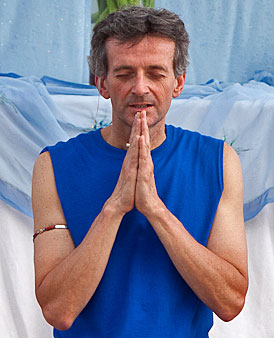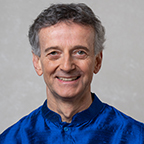This is article is shared by Gyandev McCord of the Ananda Yoga® tradition.
Gyandev McCord of the Ananda Yoga® tradition.
We are excited to welcome Nayaswami Gyandev for the 27th Anniversary of the SOYA Annual Retreat in Sorrento, BC this June 3-5, 2022. Pick up your copy of his book Spiritual Yoga: Awakening to Higher Awareness at the retreat or order online here.
 We often emphasize that Ananda Yoga takes a spiritual approach to hatha yoga (the postures and breathing techniques). But what does that mean, and how does that make Ananda Yoga different?
We often emphasize that Ananda Yoga takes a spiritual approach to hatha yoga (the postures and breathing techniques). But what does that mean, and how does that make Ananda Yoga different?
First, let’s make it clear what “spiritual” means. It isn’t about having visions, talking about “deep stuff,” or being religious. Spirituality is about consciousness—your consciousness, your experiential connection with higher realities. Above all, it’s about attaining dynamic, lasting happiness and fulfillment.
How does that relate to hatha yoga? It’s important to realize that many of the popular expressions of hatha yoga that you see these days are completely unrelated to the original intention behind the techniques. Hatha yoga was never about getting a good workout, and it certainly wasn’t about being “cool”; hatha yoga was originally a tool for inner growth.
 In fact, more and more people are looking for exactly that in their yoga practice. The physical experience is (or should be, anyway) enjoyable, and physical benefits are great, but one cannot practice for long without sensing that, somewhere in the midst of it all, there are some other significant possibilities. It is like taking a peek through the keyhole of a door to see deeper, more meaningful levels of one’s own being.
In fact, more and more people are looking for exactly that in their yoga practice. The physical experience is (or should be, anyway) enjoyable, and physical benefits are great, but one cannot practice for long without sensing that, somewhere in the midst of it all, there are some other significant possibilities. It is like taking a peek through the keyhole of a door to see deeper, more meaningful levels of one’s own being.
But how to open the door? Can the asanas (postures), which are mere bodily positions, do that? Not if you leave the practice at a purely physical level. Certainly there are many valuable benefits even at that level, but the asanas have a far greater potential than that. Using them merely for their physical benefits is like having a Ferrari, but using it only to drive to the grocery store once in a while. Much more is possible!
How can we achieve that “much more”? This is where Ananda Yoga shines, for it takes advantage of the intimate connection between the position of your body and your state of mind. For example, suppose you’re feeling low. What happens? You tend to slump, drag your feet, look downward, exhale and sigh. Even the corners of your mouth turn downward. The mind is having a significant effect on your body.
 But it goes both ways: The body can affect the mind as well. By putting your body in the above positions—slumping, dragging, etc.—you can actually induce a feeling of unhappiness. Or to use a cheerier example, suppose that when you’re feeling low, you refuse to give in to the tendency to slump, drag, etc. Instead you intentionally stand up straight, lift your chest, look upward, inhale deeply, even raise your arms overhead. Add to that an intentional—even if somewhat forced—smile. Most of the time, those actions alone will change your state of mind, and you’ll feel much better. They’re just physical actions, but they affect the subtler, mental level of your being.
But it goes both ways: The body can affect the mind as well. By putting your body in the above positions—slumping, dragging, etc.—you can actually induce a feeling of unhappiness. Or to use a cheerier example, suppose that when you’re feeling low, you refuse to give in to the tendency to slump, drag, etc. Instead you intentionally stand up straight, lift your chest, look upward, inhale deeply, even raise your arms overhead. Add to that an intentional—even if somewhat forced—smile. Most of the time, those actions alone will change your state of mind, and you’ll feel much better. They’re just physical actions, but they affect the subtler, mental level of your being.
This is a very rough—but very useful!—example of what the asanas can do: Each has its own inherent influence on the mind. It’s subtle, so subtle that if we depend on physical position alone, the effect will usually be small. However, Ananda Yoga teaches you to use the power of your mind to cooperate with this inherent influence, and the result can be significant.
In fact, Ananda Yoga takes it a step farther, teaching you also to work with the body’s subtle energy (life-force, or prana, as it’s called in Sanskrit). This energy is the connecting link between body and mind, and by learning to bring it from theoretical vagueness into experiential clarity, you can make the result greater still.
 This, then, is the essence of Ananda Yoga: We work with the body, and with energy, and with the mind, aligning them in a single harmonious, unified direction. Even the physical benefits of the practice are magnified in this way, but far more significant is the effect on your level of vitality, your mental functions (concentration, memory, etc.), your peace of mind, your connection with God. In short, your level of happiness.
This, then, is the essence of Ananda Yoga: We work with the body, and with energy, and with the mind, aligning them in a single harmonious, unified direction. Even the physical benefits of the practice are magnified in this way, but far more significant is the effect on your level of vitality, your mental functions (concentration, memory, etc.), your peace of mind, your connection with God. In short, your level of happiness.
This is what a true spiritual practice can and must do: raise your level of happiness. You don’t have to wait for happiness to come over you in some magical way. You can have a tool that will help you create a dynamically happy state of mind! That’s what Ananda Yoga is all about.

Co-Director of the Ananda Meditation® Teacher Training, Director of Ananda Yoga®, Level 2 Ananda Yoga teacher, E-RYT 500, Raja Yoga Teacher, Spiritual Travel Host, Writer and Lecturer, Ananda Minister
Nayaswami Gyandev McCord is a longtime disciple of Paramhansa Yogananda, and a Kriyacharya (teacher of Yogananda’s Kriya Yoga meditation technique) with Ananda Sangha. He lives and teaches at Ananda Village in Northern California as well as online—primarily training yoga teachers and meditation teachers. He is a co-founder of Yoga Alliance and author of several books, including Spiritual Yoga: Awakening to Higher Awareness, as well as more than 50 yoga videos.


Recent Comments